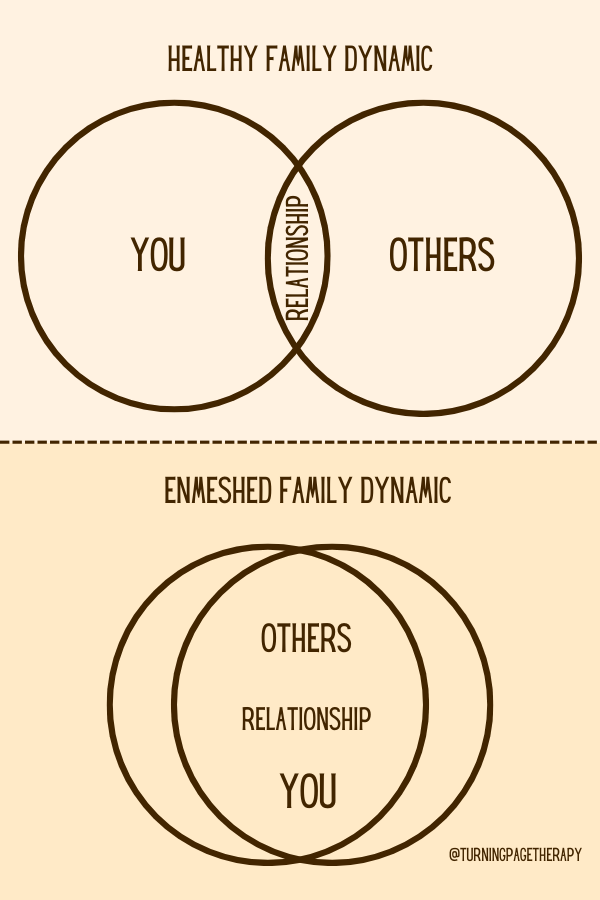Enmeshment
Here, we are discussing Enmeshment. Hopefully, by exploring this, you can recognise if it is present in your life, and when you are ready, take the next steps to change that for yourself.
[Click below to jump]
Enmeshment is a relationship
(usually family)
dynamic.
It involves a lack of boundaries between family members and often leads to or causes family roles to be confused. Because of this, you might feel close to your family, but too close. It is a complex, layered experience that affects relationship building, boundary setting and self-esteem.
Let’s explore Enmeshment together.
Family closeness is often welcome, but in this case, it causes a sense of each other’s emotions to be merged. Enmeshment tells us we are responsible for each other’s “stuff” when, in reality, that isn’t possible. We can never have a full picture of what is going on for another person. However, the type of family dynamic that builds Enmeshment often causes us to believe we are responsible for someone else’s stuff e.g. parent, sibling, grandparent, or partner.
Healthy Family Dynamic vs. Enmeshed Family Dynamic
The top image shows a healthy family dynamic. Here, both individuals can be responsible for their own stuff while still nurturing their shared relationship.
The bottom image shows an Enmeshed Dynamic. Here, others always come first, your needs are last, and each person loses part of themselves to the Dynamic/ Relationship.
What are you responsible for?
The simple answer is your stuff.
Looking at this, it may seem or feel like a lot to be for responsible but what if I told you being enmeshed means you are doing double the work and then some?
When we are Enmeshed in relationship dynamics, rather than focusing on 100% of our stuff [which is all we can be responsible for] and 50% of the relationship, we essentially manage 100% of our stuff, 100% of the relationship and 100% of other people’s stuff. That’s 300%!
Enmeshment causes us to people please and burn out. This means we are living in a way that, over time, doesn’t feel authentic to our true selves. Within an Enmeshed Dynamic, relationships tend to break down over time through unacknowledged hurt, unexpressed resentment/ anger and exhaustion from continuous boundary-breaking.
What is the root cause of Enmeshment?
The Three Causes of Enmeshment
Attachment styles
Generational Trauma
Unmet needs
Enmeshment continues because everyone in the family believes it to be the ‘norm’. When we say “norm”, it is the norm within this family dynamic. Let’s understand this more…
Attachment Styles
As a baby, you will and must attach to someone to survive. Children can’t know when they are attached to someone stable and safe. As we grow, our unspoken sense of safety develops our “Attachment style.” Our attachment style describes how we relate to those around us and is most often based on our relationship with our main caregivers in infancy and childhood.
When we attach to someone who is not able to give us a sense of safety and stability, we can develop attachment anxiety. This leads to a deep need for closeness within a relationship. Without this closeness, we will be in a place of fear of abandonment and rejection.
Generational Trauma
Generational Trauma happens when unconscious behaviours are passed from generation to generation, creating a pattern. Sometimes, the internalised unconscious behaviours empower us and give us a sense of self and belonging. In the case of enmeshment, we are encouraged to put family first in a self-sacrificial way. This causes our sense of self to wobble and blur.
So, if attachment is fundamental to our survival and we experience the generational trauma of sacrificing our needs for our family members, questioning the pattern of Enmeshment can feel like a direct threat to the attachment we have formed.
Although we don’t have the language to identify this pattern, as children, we do recognise the feeling of “letting our parents/caregivers down.” Children are very adaptable and quickly recognise that to function in the enmeshed family dynamic, they must suppress their needs to remain attached. This creates a cycle for each child who enters the family; we become part of the cycle simply to survive until someone recognises and breaks it.
Unmet needs
When our needs aren’t met, life feels overwhelming, chaotic and unstable. If we are doing the 300% mentioned before, very little of our needs can be met. Our needs become dependent on other’s needs and fulfilment. As children, this may not be as jarring as it is as adults. Children are dependent on the adults around them to help navigate the world, but as adults, we want a balanced sense of belonging and independence. When we see our peers have this, we naturally want it for ourselves, and so, questioning the cycle of enmeshment begins.
Next time in The Therapy Pages…
Breaking any generational cycle is exhausting. It can feel like an inner battle between what you believe you “should” do and what you know you need to do now. In the next post, I’ll be helping you understand Generational Trauma in more detail.
Hi 👋 I’m Kelly!
Meet the Face behind the Blog
I’m a Counsellor & Psychotherapist. I find passion in helping others navigate their complex family relationships, estrangement and all the layers that come with these experiences. I have personal experience in most areas I work and find this adds depth to the relationships my clients and I build.
Outside of work, I love escaping to other worlds through reading. I’m a cat lover and find the most joy in my life when it feels settled, quiet and slow-paced.








